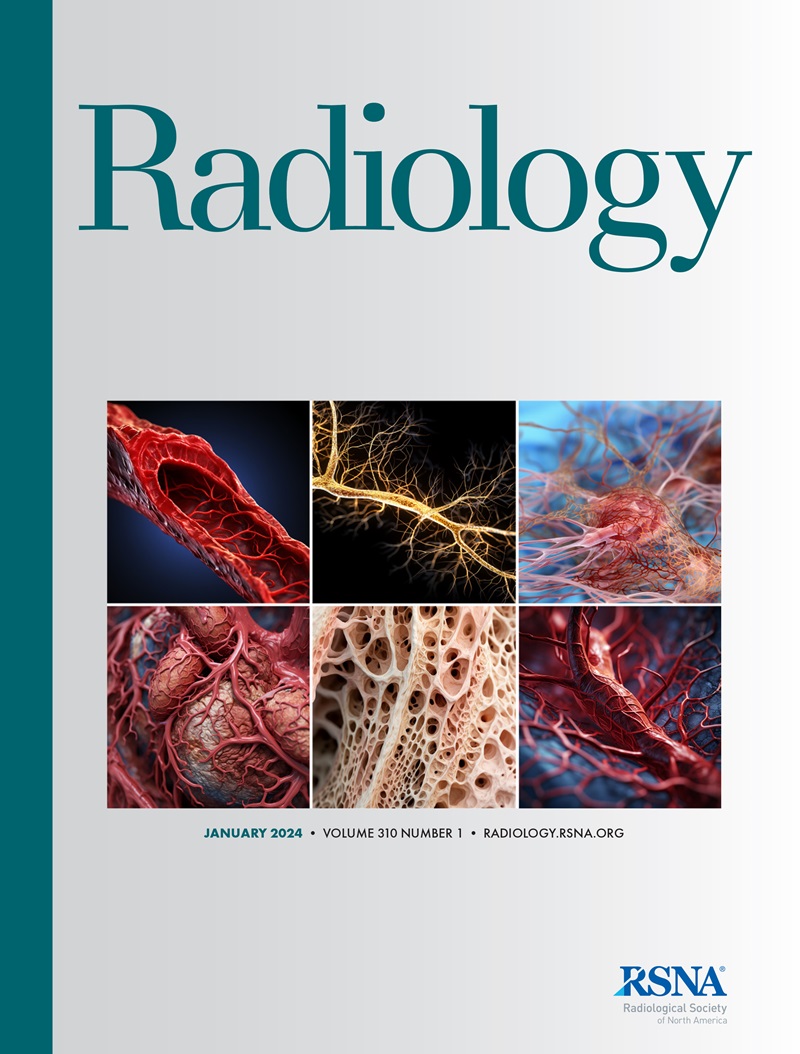Yarong Yu, Dijia Wu, Jiajun Yuan, Lihua Yu, Xu Dai, Wenli Yang, Ziting Lan, Jiayu Wang, Ze Tao, Yiqiang Zhan, Runjianya Ling, Xiaomei Zhu, Yi Xu, Yuehua Li, Jiayin Zhang
求助PDF
{"title":"基于深度学习的定量CT心肌灌注成像与冠状动脉疾病风险分层。","authors":"Yarong Yu, Dijia Wu, Jiajun Yuan, Lihua Yu, Xu Dai, Wenli Yang, Ziting Lan, Jiayu Wang, Ze Tao, Yiqiang Zhan, Runjianya Ling, Xiaomei Zhu, Yi Xu, Yuehua Li, Jiayin Zhang","doi":"10.1148/radiol.242570","DOIUrl":null,"url":null,"abstract":"<p><p>Background Precise assessment of myocardial ischemia burden and cardiovascular risk stratification based on dynamic CT myocardial perfusion imaging (MPI) is lacking. Purpose To develop and validate a deep learning (DL) model for automated quantification of myocardial blood flow (MBF) and ischemic myocardial volume (IMV) percentage and to explore the prognostic value for major adverse cardiovascular events (MACE). Materials and Methods This multicenter study comprised three cohorts of patients with clinically indicated CT MPI and coronary CT angiography (CCTA). Cohorts 1 and 2 were retrospective cohorts (May 2021 to June 2023 and January 2018 to December 2022, respectively). Cohort 3 was prospectively included (November 2016 to December 2021). The DL model was developed in cohort 1 (training set: 211 patients, validation set: 57 patients, test set: 90 patients). The diagnostic performance of MBF derived from the DL model (MBF<sub>DL</sub>) for myocardial ischemia was evaluated in cohort 2 based on the area under the receiver operating characteristic curve (AUC). The prognostic value of the DL model-derived IMV percentage was assessed in cohort 3 using multivariable Cox regression analyses. Results Across three cohorts, 1108 patients (mean age: 61 years ± 12 [SD]; 667 men) were included. MBF<sub>DL</sub> showed excellent agreement with manual measurements in the test set (segment-level intraclass correlation coefficient = 0.928; 95% CI: 0.921, 0.935). MBF<sub>DL</sub> showed higher diagnostic performance (vessel-based AUC: 0.97) over CT-derived fractional flow reserve (FFR) (vessel-based AUC: 0.87; <i>P</i> = .006) and CCTA-derived diameter stenosis (vessel-based AUC: 0.79; <i>P</i> < .001) for hemodynamically significant lesions, compared with invasive FFR. Over a mean follow-up of 39 months, MACE occurred in 94 (14.2%) of 660 patients. IMV percentage was an independent predictor of MACE (hazard ratio = 1.12, <i>P</i> = .003), with incremental prognostic value (C index: 0.86; 95% CI: 0.84, 0.88) over conventional risk factors and CCTA parameters (C index: 0.84; 95% CI: 0.82, 0.86; <i>P</i> = .02). Conclusion A DL model enabled automated CT MBF quantification and accurate diagnosis of myocardial ischemia. DL model-derived IMV percentage was an independent predictor of MACE and mildly improved cardiovascular risk stratification. © RSNA, 2025 <i>Supplemental material is available for this article.</i> See also the editorial by Zhu and Xu in this issue.</p>","PeriodicalId":20896,"journal":{"name":"Radiology","volume":"315 1","pages":"e242570"},"PeriodicalIF":12.1000,"publicationDate":"2025-04-01","publicationTypes":"Journal Article","fieldsOfStudy":null,"isOpenAccess":false,"openAccessPdf":"","citationCount":"0","resultStr":"{\"title\":\"Deep Learning-based Quantitative CT Myocardial Perfusion Imaging and Risk Stratification of Coronary Artery Disease.\",\"authors\":\"Yarong Yu, Dijia Wu, Jiajun Yuan, Lihua Yu, Xu Dai, Wenli Yang, Ziting Lan, Jiayu Wang, Ze Tao, Yiqiang Zhan, Runjianya Ling, Xiaomei Zhu, Yi Xu, Yuehua Li, Jiayin Zhang\",\"doi\":\"10.1148/radiol.242570\",\"DOIUrl\":null,\"url\":null,\"abstract\":\"<p><p>Background Precise assessment of myocardial ischemia burden and cardiovascular risk stratification based on dynamic CT myocardial perfusion imaging (MPI) is lacking. Purpose To develop and validate a deep learning (DL) model for automated quantification of myocardial blood flow (MBF) and ischemic myocardial volume (IMV) percentage and to explore the prognostic value for major adverse cardiovascular events (MACE). Materials and Methods This multicenter study comprised three cohorts of patients with clinically indicated CT MPI and coronary CT angiography (CCTA). Cohorts 1 and 2 were retrospective cohorts (May 2021 to June 2023 and January 2018 to December 2022, respectively). Cohort 3 was prospectively included (November 2016 to December 2021). The DL model was developed in cohort 1 (training set: 211 patients, validation set: 57 patients, test set: 90 patients). The diagnostic performance of MBF derived from the DL model (MBF<sub>DL</sub>) for myocardial ischemia was evaluated in cohort 2 based on the area under the receiver operating characteristic curve (AUC). The prognostic value of the DL model-derived IMV percentage was assessed in cohort 3 using multivariable Cox regression analyses. Results Across three cohorts, 1108 patients (mean age: 61 years ± 12 [SD]; 667 men) were included. MBF<sub>DL</sub> showed excellent agreement with manual measurements in the test set (segment-level intraclass correlation coefficient = 0.928; 95% CI: 0.921, 0.935). MBF<sub>DL</sub> showed higher diagnostic performance (vessel-based AUC: 0.97) over CT-derived fractional flow reserve (FFR) (vessel-based AUC: 0.87; <i>P</i> = .006) and CCTA-derived diameter stenosis (vessel-based AUC: 0.79; <i>P</i> < .001) for hemodynamically significant lesions, compared with invasive FFR. Over a mean follow-up of 39 months, MACE occurred in 94 (14.2%) of 660 patients. IMV percentage was an independent predictor of MACE (hazard ratio = 1.12, <i>P</i> = .003), with incremental prognostic value (C index: 0.86; 95% CI: 0.84, 0.88) over conventional risk factors and CCTA parameters (C index: 0.84; 95% CI: 0.82, 0.86; <i>P</i> = .02). Conclusion A DL model enabled automated CT MBF quantification and accurate diagnosis of myocardial ischemia. DL model-derived IMV percentage was an independent predictor of MACE and mildly improved cardiovascular risk stratification. © RSNA, 2025 <i>Supplemental material is available for this article.</i> See also the editorial by Zhu and Xu in this issue.</p>\",\"PeriodicalId\":20896,\"journal\":{\"name\":\"Radiology\",\"volume\":\"315 1\",\"pages\":\"e242570\"},\"PeriodicalIF\":12.1000,\"publicationDate\":\"2025-04-01\",\"publicationTypes\":\"Journal Article\",\"fieldsOfStudy\":null,\"isOpenAccess\":false,\"openAccessPdf\":\"\",\"citationCount\":\"0\",\"resultStr\":null,\"platform\":\"Semanticscholar\",\"paperid\":null,\"PeriodicalName\":\"Radiology\",\"FirstCategoryId\":\"3\",\"ListUrlMain\":\"https://doi.org/10.1148/radiol.242570\",\"RegionNum\":1,\"RegionCategory\":\"医学\",\"ArticlePicture\":[],\"TitleCN\":null,\"AbstractTextCN\":null,\"PMCID\":null,\"EPubDate\":\"\",\"PubModel\":\"\",\"JCR\":\"Q1\",\"JCRName\":\"RADIOLOGY, NUCLEAR MEDICINE & MEDICAL IMAGING\",\"Score\":null,\"Total\":0}","platform":"Semanticscholar","paperid":null,"PeriodicalName":"Radiology","FirstCategoryId":"3","ListUrlMain":"https://doi.org/10.1148/radiol.242570","RegionNum":1,"RegionCategory":"医学","ArticlePicture":[],"TitleCN":null,"AbstractTextCN":null,"PMCID":null,"EPubDate":"","PubModel":"","JCR":"Q1","JCRName":"RADIOLOGY, NUCLEAR MEDICINE & MEDICAL IMAGING","Score":null,"Total":0}
引用次数: 0
引用
批量引用

 求助内容:
求助内容: 应助结果提醒方式:
应助结果提醒方式:


